| Year | Population |
|---|---|
| 1970 | 11,452 |
| 1980 | 11,172 |
| 1990 | 10,550 |
| 2000 | 9,511 |
| 2010 | 9,692 |
| Geographic Data | |
|---|---|
| N. Latitude | 46:41:10 |
| W. Longitude | 67:59:14 |
| Maine House | Dist 147,147 |
| Maine Senate | District 2 |
| Congress | District 2 |
| Area sq. mi. | (total) 77.6 |
| Area sq. mi. | (land) 75.8 |
| Population/sqmi | (land) 127.9 |
County: Aroostook
Total=land+water; Land=land only |
|
[presk IYL] is a city in Aroostook County, settled in 1828 and incorporated on April 4, 1859 from Plantations from F, G and H. It annexed the town of Maysville in 1883 and was incorporated as a city on January 1, 1940.
The French presque isle means “almost an island,” based on the twists and turns of the Aroostook River and the Presque Isle Stream.
The community was first connected with the “outside” when the road up from Monticello was completed in 1839. The first mail was brought on horseback three years later.
The substantial agricultural fair held each year began as the first Cattle Show and Fair in 1851.
Presque Isle is now home to an Agricultural Experiment Station, known as Aroostook Farm, and a unit of the University of Maine’s College of Natural Sciences, Forestry and Agriculture.
After the “Great Fire” of 1884, electric lights started to replace more flammable lighting options in 1887.
During World War II, Presque Isle was a vital stop for ferrying aircraft to Britain across the Atlantic.
The University of Maine campus here provides educational and cultural opportunities for area residents. Aroostook State Park is located at the southern end of the town, on Echo Lake.
With many fine houses and a historic downtown, Presque Isle has its commercial strip like so many other communities. The City is the hub of Maine Routes 10, 163, 167, 227 and U.S. Route 1.
The University of Maine at Presque Isle’s “Maine Solar System Model” has placed planets at scale intervals on U.S. Route 1. Presque Isle hosts the Sun and several planets, including Jupiter. Other planets are at Littleton, Topsfield, and Westfield.
Aroostook State Park is the oldest in the State having been opened in 1939. About three miles south of downtown Presque Isle off U.S. Route 1, it has frontage on Echo Lake. This is an all-season park featuring winter and summer recreation opportunities. More.
After careful planning and knowing the history of previous failed attempts, the three person crew of Double Eagle II lifted off from Presque Isle on August 12, 1978 seeking to make the first transatlantic balloon flight. When it landed in a barley field near Paris, 137 hours and 3,233 miles later, the feat was secured. A park in Presque Isle now memorializes the adventure. The original Double Eagle II is in the Smithsonian Museum in Washington, DC.
Form of Government: Council-Manager
Additional resources
Image credit: “Presque Isle Birdseye View 1894.” LC classification: G3734.P9A3 1894 .N6 Repository: Library of Congress Geography and Map Division Washington, D.C. 20540-4650 USA dcu. Digital ID: G3734P Pm002500 Http://Hdl.Loc.Gov/Loc.Gmd/G3734P.Pm002500. Image source: http://www.loc.gov/item/75693249 (accessed March 19, 2013)
125th Birthday Committee presents “City of Presque Isle: 125th historical booklet, 1859-1984.” Presque Isle, Me.? Presque Isle Area Chamber of Commerce. c1984.
Allen, John. The Day Book of John Allen, 1840-1850 [1835-1855]. Title on Presque Isle Historical Society’s typescript: John Allen of Maysville, 1800-1887: a farm journal for years 1835-1855. [University of Maine, Presque Isle, Special Collections.]
An Environmental Assessment of Planned PL566 Construction on the Presque Isle Stream Watershed for United States Department of Agriculture, Soil Conservation Service. [prepared by] Wright, Pierce, Barnes & Wyman. Topsham, Me. The Engineers. 1976. [University of Maine, Fogler Library, Special Collections.]
Clark, Marilyn Graffam. History, 1865-1965, Congregational Church, Presque Isle, Maine. Presque Isle, Me.? The Church. 1965? [University of Maine, Presque Isle, Special Collections.]
Davis, Pauline. Rebecca and John: Northern Maine Homesteaders, 1866. Skowhegan, Maine. Somerset Reporter Co. c1978.
Graves, Laila. Glimpses of our Local History. Presque Isle, Me Star Herald. 1984. [University of Maine, Presque Isle, Special Collections.]
Graves, Richard A. Forgotten Times: Presque Isle’s First 150 years. Presque Isle, Me. The Author. c2006. (Presque Isle: Northeast Publishing) [University of Maine, Presque Isle, Special Collections.]
History of Presque Isle 1929-1975. Contains: History of Presque Isle / Elisabeth Ashby (now Underwood). — written 1919 ; He knew Presque Isle / Miss Hattie Barker. — 1929 ; Glimpses of our local history / Mrs. Laila Graves (Mrs. Sydney). — 1984 ; History of Presque Isle, Maine / Chamber of Commerce. — [1975?] Typescripts (photocopy) [University of Maine, Presque Isle, Special Collections.]
History of Presque Isle Project. Cunningham Middle School, Presque Isle, Maine; 8th grade. Presque Isle, Me. The School. 2005. [University of Maine, Presque Isle, Special Collections.]
History of St. John’s Episcopal Church, Presque Isle, Maine, 1869-2004. [edited by Kay Gauffreau]. Presque Isle, Me. The Church. 2004. [University of Maine, Presque Isle, Special Collections.]
Hodshon, Gail. A General History of Events on Main Street in Presque Isle. Presque Isle, Me. The Author. 1983. [University of Maine, Presque Isle, Special Collections.]
Important Data in the History of Presque Isle. Compiled by Roland T. Patten, editor of the Star-Herald. Presque Isle, Me.? Star-Herald Publishing Co. 1932?
McCarry, Charles. Double Eagle: Ben Abruzzo, Maxie Anderson, Larry Newman. Boston: Little, Brown. c1979
*Maine. Historic Preservation Commission. Augusta, Me. Text and photos from National Register of Historic Places: http://pdfhost.focus.nps.gov/docs/nrhp/text/xxxxxxxx.PDF and http://pdfhost.focus.nps.gov/docs/nrhp/photos/xxxxxxxx.PDF
Presque Isle National Bank: 86002106.PDF
US Post Office–Presque Isle: 86001034.PDF
Park, George M. Presque Isle History. Presque Isle, Me. The Author. 1916?
Pioneer Presque Isle: to 1859. Edited by Dale R. Steinhauer. Presque Isle, Me. 125th Anniversary Committee. 1984.
Presque Isle Maine: “A Town Worth While.” Presque Isle, Me. Merchants Association. 1932.
Presque Isle, 1820-1920. General Committee. Presque Isle, Me.? 1920?
Savage, D. A. A Fire History of Presque Isle. Presque Isle, Me. The Author. 1984. [University of Maine, Presque Isle, Special Collections.]
Tasker, William J. The Pioneer Homes of Presque Isle, Maine: including Maysville. Caribou, Me. Monkey Publishing. c2007.
National Register of Historic Places – Listings
Presque Isle National Bank
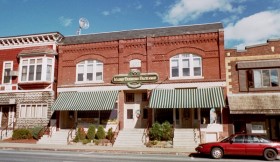 [422 Main Street] The entire commercial center of Presque Isle was destroyed by a major fire in 1884. Rebuilding included the construction of the National Bank block in 18871. This structure is the most architecturally important commercial block in northern Maine above Houlton. One half of the bank block was financed by the stockholders of the bank and the other half by a local businessman, C. F. A. Johnson. The new bank opened on January 2, 1888 with a capital of $50,000. The bank, a victim of the Depression, closed in March, 1933. Recently it has been known as the Maine Farmers Exchange.
[422 Main Street] The entire commercial center of Presque Isle was destroyed by a major fire in 1884. Rebuilding included the construction of the National Bank block in 18871. This structure is the most architecturally important commercial block in northern Maine above Houlton. One half of the bank block was financed by the stockholders of the bank and the other half by a local businessman, C. F. A. Johnson. The new bank opened on January 2, 1888 with a capital of $50,000. The bank, a victim of the Depression, closed in March, 1933. Recently it has been known as the Maine Farmers Exchange.
The building’s importance as a center of commerce is based on its occupancy by the bank between 1887 and 1933. This was the most important period of development for Aroostook county. Aroostook County is known for its potato industry, both as a crop for export and in the manufacture of starch. The Bank was critical in financing development during these prosperous years. Indeed, C.F.A. Johnson, one of the principal share holders, was known as the “starch king”. The local newspaper, The Northern Star, occupied half the building for a number of years.
The building is the only architecturally distinctive 19th century block to survive in the northern half of the county, an area that includes the small cities of Presque Isle, Caribou and Fort Fairfield. Much of the pre-1900 building stock in the region was replaced in the first quarter of the 20th century or has been demolished.
US Post Office–Presque Isle
[23 Second Street] The Presque Isle Post Office incorporates the elements of Classic Revival Design. It was planned to be an architectural symbol of the Federal Government. In the early 1930s when the country was beginning to feel the effects of the depression, the design and construction of post offices were an important attempt to rejuvenate the economy and offer relief to the design and construction industry.
There was an effort to construct buildings symbolic of government strength and ideals and to see them as an effort on the part of the Government to sponsor prosperity. Location, visibility and access were necessary to reinforce the idea of the Federal presence. The Presque Isle Post Office’s raised position on this site, its color, sensitive proportions and scale enhances an otherwise architecturally undistinguished neighborhood.
With the attention given to the siting of the building, the formal design, and the quality of the construction, the Post Office has continued its traditional role as an example of stability and confidence now and during a most difficult era in American history.*


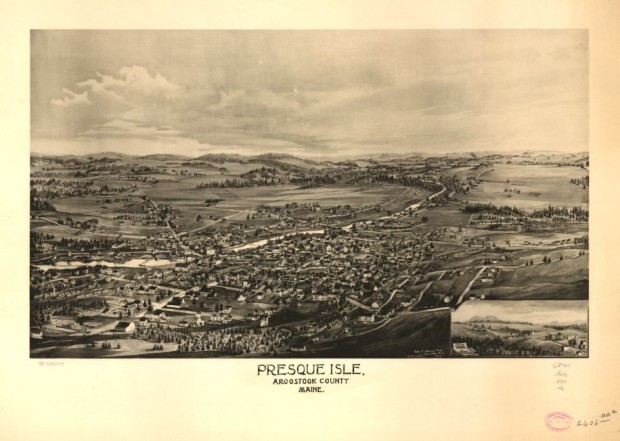
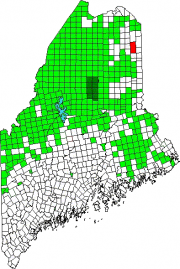
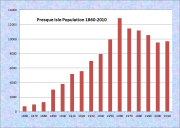

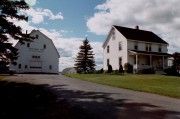
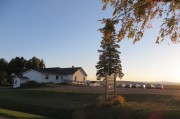

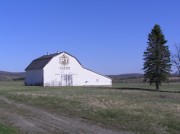
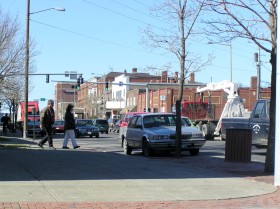

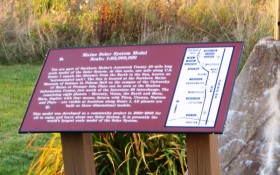



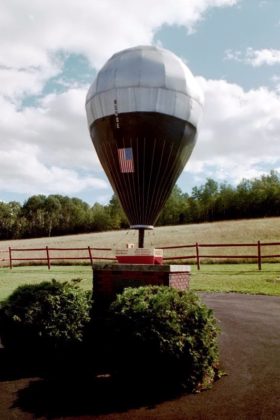


U. S. Post Office location is correct at the bottom, but the picture caption incorrectly shows it to be on Route 1.